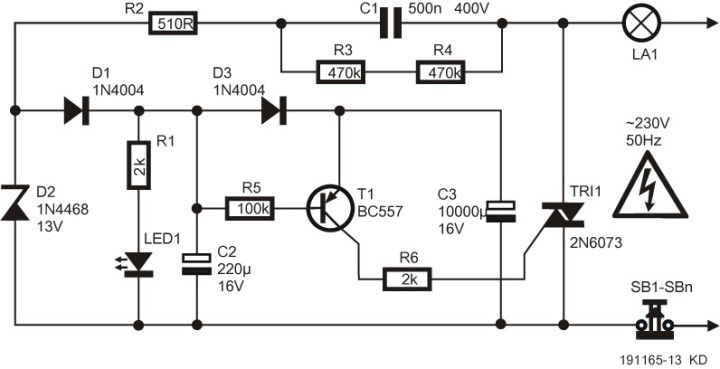Small Circuits Revival – Episode 3
on
Energy Efficient Relay
idea: Michael A. Shustov (Russia) and Andrey M. Shustov (Germany)
Variant 3
AC voltages cannot be switched using a ‘normal’ semiconductor switch (transistor or MOSFET); for this we require either an electromechanical relay or a special component that is called a triac. The very abbreviated summary: we can imagine a triac as two thyristors connected in anti-parallel.

In the idle state with none of the series connected, push to break switches SB1-SBn pushed, a small current flows through the lamp, capacitor C1, resistor R2, diode D1 and resistor R1, causing LED1 to light and holding off transistor T1. Via D3, capacitor C3 is fully charged to a little under the zener voltage set by D2 (i.e. about 13 V minus the forward voltage drops of D1 and D3).
As soon as one of the switches is pushed briefly (!) and then released, pnp transistor T1 starts to conduct (its base is pulled ‘low’) and capacitor C3 gets discharged via T1 and R6 into the gate (control input) of the triac.
With the indicated component value for C3 (10,000 µF), the triac will continue to conduct for about 27 seconds (a little less than 3 seconds per 1000 µF). Once the gate current has diminished to a level that is too small to keep the triac in conduction, the lamp will go out and after a few seconds, during which C3 is charged again, the idle state is restored.
Two observations
Firstly: this circuit has has to be built such that it is safe to use and complies with all the requirements of circuits connected to the AC powerline. Next week we will go further into that. And secondly: with version 2 we already noted that the MOSFETS used could, in theory, switch large currents (20 or 30 A, depending on the type). A reader has commented that normal, low-voltage pushbuttons are not suitable for such large currents.
But that is cuckoo! To obtain a current of 20 A at a voltage of 12 V we would have to switch a lamp that is rated 240 W. And, for a low-voltage circuit (battery powered), this appeared sufficiently absurd for us to not mention this scenario...



Discussion (3 comments)
Blackdog 5 years ago
George Assimakis 5 years ago
you can use parallel switches (normaly open) to discharge C2, maybe via a resistor 10R to 100R.
Additional, you can put inside every parallel switch, an indicator like R1-LED1. If you use many
parallel switches you maybe need to increase C1.
gert-ce 5 years ago